Nikko
Nikko is a small city at the entrance to Nikko National Park. It is most famous for the Toshogu, Japan's most lavishly decorated shrine complex and mausoleum of Tokugawa Ieyasu, the founder of the Tokugawa shogunate.
Nikko has been a center of Shinto and Buddhist mountain worship for many centuries, and Nikko National Park continues to offer scenic, mountainous landscapes, lakes, waterfalls, hot springs, wild monkeys and hiking trails.
Nikko and the area around Lake Chuzenji, in particular, are well known for their beautiful autumn foliage (koyo). The best times to view the leaves depends on the elevation and year: For Yumoto and Lake Chuzenji it is usually mid October and for central Nikko early to mid November.
Nikko is located along Japan's Romantic Road.
Toshogu Shrine
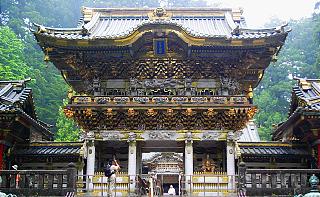
The Toshogu is the mausoleum of Tokugawa Ieyasu, founder of the Tokugawa shogunate, which ruled Japan for over 250 years until 1868. The shrine is dedicated to the spirits of Ieyasu and two other of Japan's most influential historical personalities, Toyotomi Hideyoshi and Minamoto Yoritomo.
The lavishly decorated shrine complex consists of more than a dozen Shinto and Buddhist buildings set in a beautiful forest. Initially a relatively simple mausoleum, Toshogu was enlarged into the spectacular complex seen today by Ieyasu's grandson Iemitsu during the first half of the 17th century.
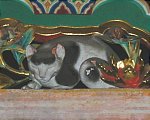 | 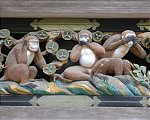 | 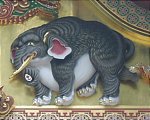 |
| Three of the Toshogu's most famous carvings | ||
Countless wood carvings and large amounts of gold leaf were used to decorate the buildings in a way not seen elsewhere in Japan, where simplicity has been traditionally stressed in shrine architecture.
Unless you intend to visit only the Toshogu, it is recommended to purchase a combination ticket, which also includes admission to the Rinnoji, Taiyuinbyo and Futarasan Shrine. However, combination ticket holders need to pay an additional fee for viewing the nemuri neko carving and Ieyasu's tomb.
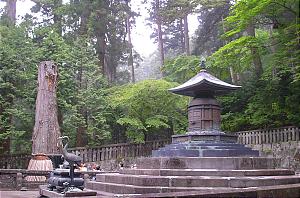
Toshogu and Nikko's other main shrines and temples are located a 30 minute walk or 10 minute bus ride (300 Yen one way, 500 Yen day pass, covered by the Tobu free passes) from Tobu and JR Nikko Stations.
Regular Ticket: 1300 Yen (includes admission to all parts of the shrine)
Combination Ticket: 1000 Yen (does not include admission to the nemuri neko carving and Ieyasu's tomb. An additional 520 Yen is required to see that part of the shrine. The ticket also includes admission to Rinnoji, Taiyuinbyo and Futarasan Shrine.)
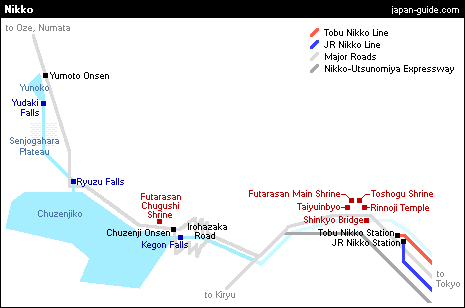
Taiyuinbyo
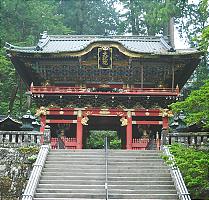 | 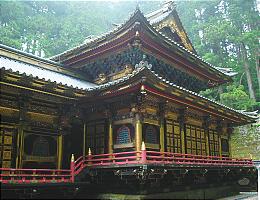 |
The Taiyuinbyo is the mausoleum of the third Tokugawa shogun, Iemitsu, the grandson of Ieyasu. The Taiyuinbyo resembles the Toshogu in its layout and lavish decorations, but it is intentionally kept more modest than the Toshogu.
Like the Toshogu, the Taiyuinbyo combines many Shinto and Buddhist elements. Taiyuinbyo belongs to Rinnoji Temple.
When visiting Iemitsu's mausoleum, it is recommended to purchase a combination ticket, which also includes admission to the Toshogu, the Rinnoji's Sanbutsudo and Futarasan Shrine.
Taiyuinbyo stands about 200 meters west of Toshogu, a 30 minute walk or 10 minute bus ride (300 Yen one way, 500 Yen day pass, covered by the Tobu free passes) from Tobu and JR Nikko Stations.
Regular Ticket: 550 Yen
Combination Ticket: 1000 Yen (also includes admission to Toshogu, Rinnoji and Futarasan Shrine.)
Rinnoji
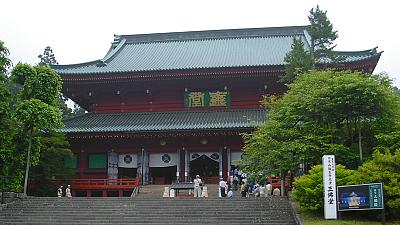
Rinnoji is Nikko's most important temple. It was founded by Shodo Shonin, the Buddhist monk who introduced Buddhism to Nikko in the 8th century.
The temple's main building, the Sanbutsudo, houses large, gold lacquered, wooden statues of Amida, Senju-Kannon ("Kannon with a thousand arms") and Bato-Kannon ("Kannon with a horse head"). The three deities are regarded as Buddhist manifestations of Nikko's three mountain kami ("Shinto gods") enshrined at Futarasan Shrine.
Opposite Sanbutsudo stands the temple's treasure house with Buddhist and Tokugawa related exhibits. Shoyoen, a small Japanese style garden, is located next to the treasure house.
To view the interior of the Sanbutsudo, it is recommended to purchase a combination ticket which also includes admission to the Toshogu, Taiyuinbyo and Futarasan Shrine. However, a separate admission fee applies to Rinnoji's treasure house and Shoyoen.
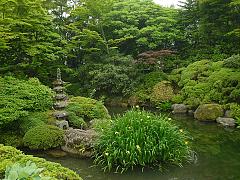 | 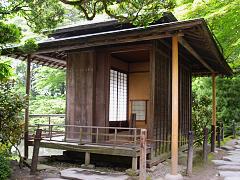 |
Rinnoji's Sanbutsudo stands just a few steps east of Toshogu, a 30 minute walk or 10 minute bus ride (300 Yen one way, 500 Yen day pass, covered by the Tobu free passes) from Tobu and JR Nikko Stations.
Sanbutsudo: 400 Yen
Treasure House and Shoyoen Garden: 300 Yen
Combination Ticket: 1000 Yen (includes admission to Sanbutsudo, but not to the treasure house and Shoyoen garden. The ticket also includes admission to Toshogu, Taiyuinbyo and Futarasan Shrine.)
Futarasan Shrine
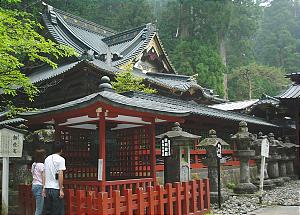
Futarasan Shrine was founded in 782 by Shodo Shonin, the Buddhist monk who introduced Buddhism to Nikko and who also founded nearby Rinnoji Temple.
Futarasan Shrine is dedicated to the kami ("Shinto gods") of Nikko's three most sacred mountains Mt. Nantai, Mt. Nyoho and Mt. Taro. Two more Futarasan Shrines stand at the shore of Lake Chuzenji and on the summit of Mount Nantai.
Futarasan Shrine stands about 200 meters west of Toshogu, a 30 minute walk or 10 minute bus ride (300 Yen one way, 500 Yen day pass, covered by the Tobu free passes) from Tobu and JR Nikko Stations.
Regular Ticket: 200 Yen
Combination Ticket: 1000 Yen (also includes admission to Toshogu, Taiyuinbyo and Rinnoji.)
Lake Chuzenji
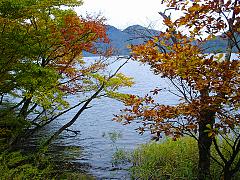 | 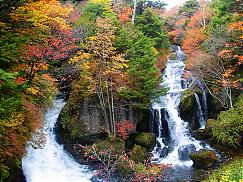 |
Lake Chuzenji (Chuzenjiko) is a beautiful lake with forested shores at the foot of the sacred volcano Mount Nantai in Okunikko ("Inner Nikko"). The lake was formed by lava flows of the now extinct volcano several thousand years ago. It is part of Nikko National Park.
Access to Lake Chuzenji and the inner regions of the national park is via the "Irohazaka Winding Road". The road ascends more than 400 meters in altitude and is named "Iroha", because the original road consisted of 48 needlepoint curves, the same number as there are letters in the Japanese syllabary, formerly known as "iroha". There are separate roads for uphill and downhill traffic.
Chuzenji Onsen, a touristy hot spring resort, is located at the top of the Irohazaka road, at the eastern end of the lake. The resort's most popular attraction is the Kegon-no-taki, a spectacular, 97 meter high waterfall. The base of the waterfall can be accessed via an elevator.
A nice panoramic view of the Kegon Falls and Lake Chuzenji can be enjoyed from the Akechidaira Plateau, which is accessible via a ropeway or on foot. To take the ropeway, get off at the Akechidaira bus stop, one stop before Chuzenji Onsen (served only by buses heading in direction of Chuzenji Onsen).
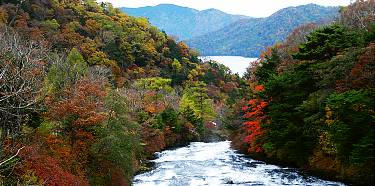
At the resort's edge stands the second of the three Futarasan Shrines (the main shrine stands in central Nikko and the third on the summit of Mount Nantai). The trail to the summit of Mount Nantai starts from the shrine grounds. There is also a treasure house which displays some impressive swords.
A few hundred meters upstream from the confluence of Yukawa River into Lake Chuzenji, rumble the Ryuzu Falls, another set of spectacular waterfalls, particularly nice during the autumn leaf season, which usually reaches its peak in early to mid October.
Chuzenji Onsen is connected with central Nikko by bus. The Tobu operated buses leave from in Tobu Nikko Station (some also serve JR Nikko Station) and are bound for Chuzenji Onsen or Yumoto Onsen. There are about three buses per hour. The one way trip from Tobu Nikko Station to Chuzenji Onsen takes about 50 minutes and costs 1100 Yen.
To access the Ryuzu Falls, take a bus bound for Yumoto Onsen (1-2 buses per hour) and get off at "Ryuzu-no-taki" bus stop. From Tobu Nikko Station, the trip takes about one hour and costs 1350 Yen one way.
If you are visiting Lake Chuzenji from Tokyo, make sure to consider a Tobu Free Pass, which includes the round trip by train from Tokyo to Nikko and free travel on Tobu buses in the Nikko area.
Note that during peak travel seasons such as the autumn leaf season, traffic between central Nikko and Lake Chuzenji can be very heavy, and buses can incur heavy delays.
Yumoto Onsen
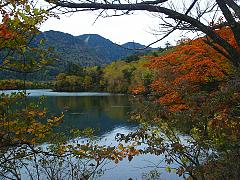 | 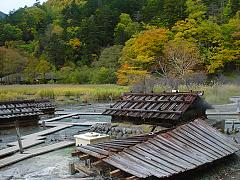 |
Yumoto (lit. "origin of hot water") is a small hot spring town in Okunikko ("Inner Nikko") and part of Nikko National Park. The town is nicely located next to Lake Yunoko (lit. "hot water lake") and consists mainly of ryokan with hot spring baths.
North of the town stands Onsenji, a small Buddhist temple with a hot spring bath open to the public. Next to the temple is Yunodaira Marsh, where most of the town's hot water bubbles up from the ground. Some hot water is also bubbling along the northern shore of Lake Yunoko and a nice sulfur odor hangs over the whole town.
Immediately south of Lake Yunoko, the lake's calm waters suddenly plunge down a steep, 70 meter high slope. The spectacular waterfall is called Yudaki (lit. "hot water waterfall"), but the water of neither the lake nor the waterfall are actually warm.
From Yudaki starts the wonderful Senjogahara Plateau Nature Trail, leading along the Yugawa River (lit. "hot water river") through the woods and across the marshland of the Senjogahara Plateau to the Ryuzu Falls at the shores of Lake Chuzenji. It takes about 2-3 hours to follow the entire trail.
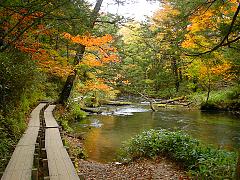 | 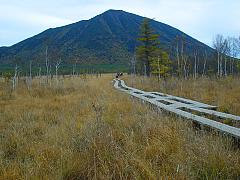 |
Yumoto Onsen is connected with central Nikko by bus. The Tobu operated buses leave from Tobu Nikko Station (some also serve JR Nikko Station). There are about one to two buses per hour. The one way trip from Tobu Nikko Station to Yumoto Onsen takes about 80 minutes and costs 1650 Yen.
If you are visiting Yumoto Onsen from Tokyo, make sure to consider a Tobu Free Pass, which includes the round trip by train from Tokyo to Nikko and free travel on Tobu buses in the Nikko area.
Note that during peak travel seasons such as the autumn leaf season, traffic between central Nikko and Yumoto Onsen can be very heavy, and buses can incur heavy delays.